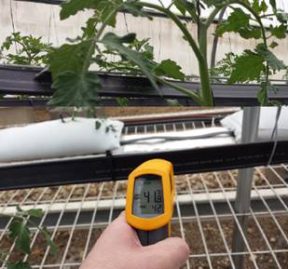Description
GFSC has developed an alternative heating system for greenhouses based on infrared radiation, allowing to heat crops in a direct way.
Using infrared radiation as a heat source is presently already a trending solution when it comes to sustainable heating systems. Common in this regard are the use of high power infrared panels that are placed within the vicinity of where the heat is needed, whether these are humans, animals or plants. Though the big disadvantage of this is, that the radiation is produced in a very high dose (high temperature) and on a very compacted area (hardly spreading of heat).
Therefore GFSC uses a totally different infrared heating concept. It is based on innovative technology whereby very thin (25/1000 mm) flexible metal ribbons are integrated in the surface on which the crops are cultivated. These ribbons have a special ‘amorphous’ molecule structure, instead of their normal ‘crystalline’ structure, due to the fact that during the production of these ribbons the temperature is reduced very quickly (more than 1 million degrees per second). Amorphous metals have sublime characteristics compared with normal metals. One of them is that they produce long-wave infrared radiation with ca. 100 % efficiency, without heating up themselves. The heating power that these ribbons generate can easily be adjusted to the needs of the individual crops. Once installed, controlling the dose of heat is simple.
GFSC Heating System advantages:
- the useless heating of enormous amounts of air can be prevented
- the desired temperature zone for the crops can be controlled much more accurately (within temperature span of 0,1 degree Celsius)
- possibility of creating different temperatures zones that lay directly adjacent to each other (something that with the present approach (‘one temperature fits all’) is presently not possible)
The result of all this is, that food production can be increased in two ways. First of all crops will grow faster, meaning that there is a 10 – 15 % increase in production per time unit. Secondly the growing process itself is stimulated, meaning that there is ca. 20 % more production of crops per sqm. Furthermore, it becomes possible to grow different types of crops (all requiring a different individual temperature zone) at the same time in the same greenhouse.
With the new heating system also huge amounts (between 40 – 50 %) of energy can be saved compared to the present situation. Due to the fact, that the infrared heating systems is electrical, it becomes possible to use locally produced renewable electricity and/or ‘green electricity’ from the grid. In this way, the system will be totally carbon neutral.
Benefits
- Farmers/owners of greenhouses can produce faster and more crops within the same time frame and within the same facilities, leading to higher production efficiency. As investment costs for this easy to install infrared system are relatively low, there is no maintenance and basically no replacement required, and energy costs can be reduced, production costs will be lowered significantly leading to higher margins
- Consumers will benefit from the new heating system as they will be provided with more and a greater variety of agricultural products. As production costs will be lowered significantly, the prices for these products will be cheaper than presently offered. Mankind in general will benefit from the infrared system, because less CO2 will be emitted so it contributes to combatting climate change




Reviews
There are no reviews yet.